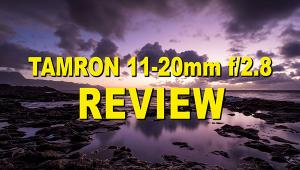Tamron SP 90mm F/2.8 Di VC USD 1:1 Macro Lens Review

I’ve always preferred longer focal-length macro lenses in the 90-100mm range because they give you more breathing room between the camera and skittish subjects than does standard (50/60mm) macros. No wonder, then, that one of my earliest lenses was the original Vivitar Series 1 90mm f/2.5 macro, which I first paired with a Minolta SR-T 102. I burned plenty of Kodachrome with that glass.
That 90mm macro lens focused to half life-size (1:2 reproduction ratio) but required an adapter—a multi-element extension tube in this case—to go to life-size (1:1). What’s more, the Vivitar lacked internal focusing, so as you focused closer, the lens barrel extended out awkwardly.

Many newer macro lenses thankfully offer internal focusing, making them easier to handle. Case in point, the Tamron SP 90mm f/2.8 VC macro model F004 and the brand–new F017 90mm macro.
When the new Tamron SP 90mm F/2.8 Di VC USD 1:1 Macro (Model F017) arrived, I was really eager to see the what this updated model brings to the table. The new lens is currently available for Canon and Nikon, with the Sony Alpha mount on pre-order at retailers.


Here’s a list of the Tamron SP 90mm F/2.8 Di VC USD 1:1 Macro (Model F017) features and price:
• Short telephoto focal length (90mm)
• Several exotic glass elements
• Reduced chromatic aberration
• Coated against flare and ghosting
• Resistant to dust and water
• Protective fluorine coating on front element
• Redesigned function switches/exterior finish
• Silent, fast AF
• Full manual focus override during AF
• Image stabilization enhanced with X-Y shift compensation
• Price (street): $649
Features and Build
The new 90mm macro feels solid and is nearly identical in build quality to its older sibling. However, on the surface and under the hood there are noteworthy differences—some visible, others unseen, a few tactile, and one audible.

The older model featured moisture-resistant construction. Tamron touts the new lens as moisture-proof and dust-resistant with seals at critical points. This lens also adds a fluorine coating on the front element to resist dirt and smudges, as on the Tamron 15–30mm zoom I tested previously.
While the fluorine coating may seem more critical on a bulbous front element, with a macro it takes the worry out of getting too close to plants that may deposit pollen on the lens and to insects that may fly into the lens or hitch a ride on the lens shade and make their way to the front element (it happens—and you don’t want to know what’s left behind).

Image stabilization, or VC (Vibration Compensation) in Tamron parlance, has also been enhanced with X-Y shift compensation. An accelerometer now works in tandem with the gyro sensor to eliminate camera shake when shooting handheld.
According to the new CIPA standards, the combined benefit is 3.5 stops in shutter speed longer than the optimum. (The optimum shutter speed is calculated as the reciprocal of effective lens focal length, or 1/90 for this lens with full-frame cameras; with APS-C cameras, multiply the focal length by the sensor factor to arrive at the effective focal length and applicable handheld shutter speed, or approximately 1/135). VC is not meant to be used when the camera is mounted to a tripod. (Note: VC is unavailable in the Sony version.)
Filter diameter on the new lens is 62mm, as opposed to 58mm on the F004. That’s a consideration if you already own lenses of smaller diameter and don’t want to spend more on filters or add stepper rings (62mm is not as common). There is a weight difference, with the new lens a mere two ounces heavier.

Manual Override For Shooting at 1:1
Compared to the older macro, the new lens has a decidedly better feel thanks to redesigned switches with more positive detents. However, while the slightly modified knurled focusing ring offers the same smooth operation, it’s a little too smooth at either end of travel—you can’t feel or hear it when you hit infinity or 1:1.
For me that’s important because I’ll often manually override AF and refocus for life-size shots without removing the camera from my eye so I can simply move in and out to lock in focus. With this lens, I find myself turning and turning and turning the focusing ring, then finally doing a visual check—and by then the subject may have moved.
The new lens also has a more polished look to it, which is nice except that it’s a fingerprint magnet. Beyond that, Tamron dropped the classy-looking gold band midway along the lens in favor of a silvery band adjacent to the lens mount. Given that the nomenclature on the two lenses is identical, aside from the model number that is subtly inscribed on the older lens and barely visible on the new one, you’ll have to look for the gold and silver bands to most easily distinguish between the two.

With regard to lens barrel design, Tamron notes: “The newly designed all-metallic barrel features an embedded concave ring at the base of the lens—for a firm hold and comfort necessary for a steady shot.” I can’t say this feature made a difference to me, but it may work for you.
Experiences In the Field
I took this lens to a variety of locations. I started with several exhibits at Chicago’s Lincoln Park Zoo, photographing a variety of animals and taking full advantage of the close-focusing capability and internal focusing. Then I moved on to the neighboring Lincoln Park Conservatory, directing my attention to some beautiful and intriguing orchids—clearly macro territory.
The ultimate challenge came when photographing live butterflies and moths in frame-filling color at the Peggy Notebaert Nature Museum butterfly haven, also in Chicago. I finally found myself shooting some scenic views and, to challenge this lens even further, set my sights on white-tail deer at a forest preserve. I’d used my older 90mm macro with deer before, but wasn’t lucky enough to get a nice tight shot. So I’d hoped to do better this time around. Spoiler alert: I did.

Results
In conjunction with my Nikon D610, autofocusing was very responsive at normal distances down to half life-size. How much of this is due to the new and improved USD actuator is open to debate since it’s difficult to quantify. I will say this: I’m thankful the lens, as with other Tamron lenses I own, features full–time manual focus override in AF mode. It made a big difference in my ability to capture flighty subjects at 1:1, where the lens tended to search endlessly, as is true with all AF macro lenses I’ve used, as I recall (much of the blame, however, goes to the camera).
Despite all that fancy glass, color fringing is visible but not easily noticeable. And it’s readily corrected with one click in Adobe Lightroom or DxO Optics Pro. Neither software, I should point out, currently supports this lens iteration. (I used the profiles for the older model F004. Given the identical names, it would be difficult to differentiate the profiles if they did exist, as neither software uses Tamron model numbers.)
Flare and vignetting were well controlled. While apparent, vignetting never dominated the picture even with the lens wide open. And it certainly improved upon stopping down—you didn’t have to go far to see a difference. Pincushion distortion was practically non-existent.
Lens Construction

As for sharpness, the lens was arguably a tad soft wide open, but that didn’t stop me from shooting at maximum aperture when light levels were low or to blur out distracting backgrounds. Stopping down to f/5.6 appeared to make a difference. Edge-to-edge and corner-to-corner sharpness were fairly even.
Conclusion
I don’t know that I’d run out to replace my fairly new Tamron 90mm macro model F004 with this Tamron SP 90mm F/2.8 Di VC USD 1:1 Macro (Model F017) version. However, if I were shopping for a macro lens this new version would be a top contender. Moisture-proof construction, smudge-proof optics, responsive AF with full-time manual override, plus user-friendly design and a good fit in your hands make this lens that much more attractive. Optically it delivers where it counts. And price-wise, it’s fairly affordable.
- Log in or register to post comments

















































